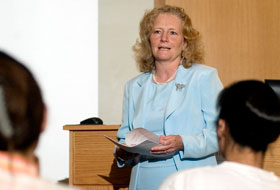  |
| HOME | THIS ISSUE | CALENDAR | GRANTS | BACK ISSUES | < BACK | NEXT > |
Seize diversity opportunities in teaching, speaker saysby Scott Brinckerhoff - September 19, 2005
|
||||
|
Opportunities to promote diversity at UConn abound in all curricula and should be seized by faculty, a member of the vice provost’s office said Wednesday. In a lively presentation to faculty members, Cathleen Love, associate vice provost for multicultural and international affairs, used anecdotes and examples to show colleagues how they can use diversity to create a better learning environment for students. “We need to ask whether we are being inclusive in our classroom, whether we are building a sense of community, or whether some students feel excluded,” she said. She urged her colleagues to examine their teaching strategies, confer with other teachers, and be open to new approaches that may reach a diverse student population better. Love, who consults nationally on diversity issues, said teachers should step back from the Eurocentric model that dominates government and academia, and instead look at how subjects might be taught or seen by people of wholly different orientations.
Being inclusive in class After some thought, he realized that the very soil under a population’s feet affects its culture and way of life — what people grow, what they build, how well they are nourished, and so on — and he wove that approach into his teaching. Another professor, teaching computer-aided design, had U.S.-born students design their ideal home. They then asked an international student to review the design. That student, not surprisingly, would have created something entirely different. As a result of sharing their approaches, Love suggested, the students gained a greater appreciation for someone else’s perspective. Another example: the “manifest destiny” taught in American history about European settlers’ sweep westward might also be taught from the perspective of Native Americans who view that period as “Eastern encroachment,” Love said. She noted that diversity, flirting as it does with political correctness, is often a subject that teachers are happy to avoid. She described a scene that’s likely to be especially familiar to suburban mothers with infants in shopping carts: “The child says, ‘Mommy, why is that lady’s skin so dark?’” Love said. “And what does the mother reply?” “Shush,” replied the audience at Babbidge Library. “And that,” Love said, “sets the foundation for how we talk about this subject for life.”
She said that well-meaning teachers can sometimes inadvertently hurt the goal of making all students feel valued, and gave the example of a professor discussing factors that determine how tall a person will be. “Your mom’s tall; your dad’s tall. Unless you’re African-American and you don’t eat right, you’re going to be tall too,” he said. The lone African-American student in the class did not appreciate the comment or the momentary spotlight, said Love.
Miniature earth study Of the 100, there would be 61 Asians, 12 Europeans, 14 North and South Americans, 13 Africans and one from Australia and its environs. Half of the population would be males, half females, and 67 percent would be something other than Christian. Ten homosexuals would be scattered among the 100. Seventy percent would have no bank account; 75 percent would not have a roof over their heads or a bed to sleep in; and 41 percent would have no basic sanitation. “The miniature earth study is a powerful tool to help people understand that here in the United States, we’re only a small slice of the planet,” Love said. Diversity awareness has been part of the U.S. cultural fabric for generations, but the old homogeneous “melting pot” description of the population is now being replaced by a new “salad” metaphor, Love said: “Isn’t a salad more appealing when each ingredient maintains its own integrity?” The workshop was one of a series of events and exhibits celebrating General Education Month at UConn. |
| ADVANCE HOME UCONN HOME |

